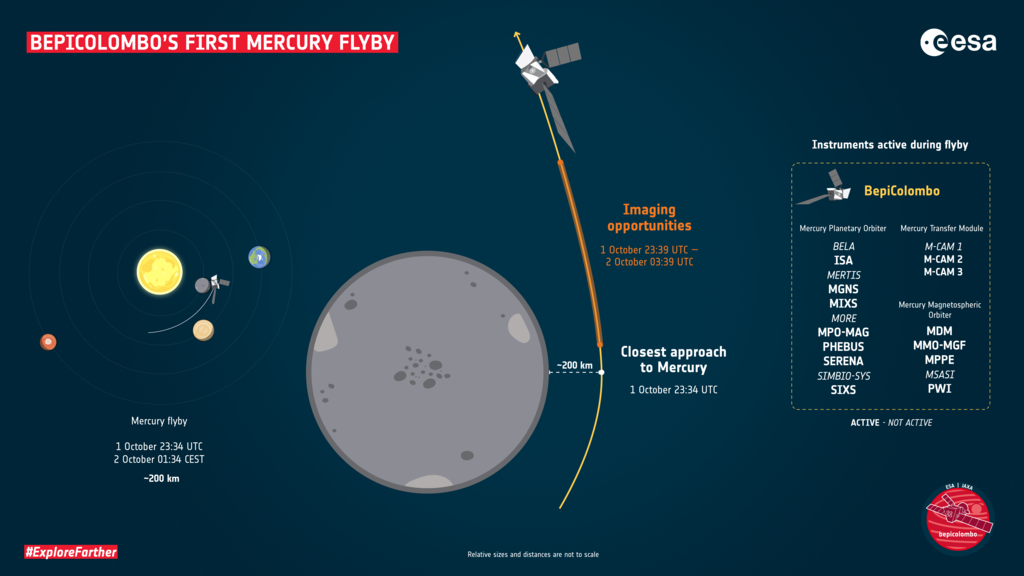
The first Mercury flyby of the BepiColombo mission
The BepiColombo space probe, launched on October 20, 2018, from the Kourou Space Centre in French Guiana, is on its way to Mercury, its final destination. The first of six flybys of the closest planet to the Sun took place on October 2, 2021, at 1.35 am Italian time (11.35 pm Greenwich Mean Time), when the probe passed at 200km from the surface.
BepiColombo has successfully completed one flyby of Earth, on April 10, 2020, and two flybys of Venus, on October 20, 2020, and August 10, 2021. The main objective of these close encounters is to modify the probe's trajectory, allowing it to gain sufficient speed for the final capture by Mercury's gravity, scheduled for the end of 2025. However, at the same time, the encounters also represent a first taste of what will be observed in much greater detail during the primary mission, when BepiColombo will orbit the planet for two years.
BepiColombo is a collaboration between ESA (European Space Agency) and JAXA (Japanese Space Agency). It is named after the Italian scientist Giuseppe (a.k.a. Bepi) Colombo, who made a fundamental contribution to the study of Mercury. The probe consists of three main modules: the MPO (Mercury Planetary Orbiter) module and the MTM (Mercury Transfer Module) developed by ESA, and the third module MMO (Mercury Magnetospheric Orbiter) developed by JAXA. With the sophisticated scientific instruments on board, BepiColombo aims to answer fundamental questions to understand the planet’s formation and evolution: what is its internal structure, from the core to the surface? Which elements and minerals are its constituents? What is the origin of the magnetic field, and how does it interact with the solar wind, a flow of particles coming from the sun at a speed of 400 km/s?
Four out of sixteen scientific experiments of BepiColombo's are Italian. Among these, the MORE (Mercury Orbiter Radioscience Experiment) is led by Professor Luciano Iess of the Department of Mechanical and Aerospace Engineering at Sapienza University, assisted by an international team of scientists and engineers. In Italy, the Universities of Pisa and Bologna, INAF - Istituto Nazionale di Astrofisica (Italian National Institute for Astrophysics) and the Università d'Annunzio are involved in the project. MORE's scientific objectives are the determination of Mercury's interior structure through precision measurements of the planet's gravity, the search for violations of Einstein's theory of general relativity and the demonstration of a novel, advanced space navigation syste.
Mercury is the closest planet to the Sun, where the curvature of space-time, predicted by Einstein in 1915, is most pronounced. This curvature produces 'anomalies' in the planet's orbit (including the famous perihelion precession) and the propagation of light and radio signals (including the deflection observed during the 1919 solar eclipse). Nearly a century later, MORE will be able to test whether Einstein's relativity remains a valid theory of gravity at a level of precision never achieved before. The first fundamental physics experiments began in March 2021 and will continue until the mission ends in 2027.
MORE aims to achieve these scientific goals by using radio signals exchanged between large ground antennas (34 m in diameter) located in Argentina and California, and an on-board instrument, the KaT (Ka-band Transponder), built by Thales Alenia Space Italia with the collaboration of the Sapienza team and funded by the Italian Space Agency. The advanced radio system will enable measurements the probe's distance to within a few centimeters and its speed to within a few thousandths of a millimeter per second. Data from another Italian instrument (Italian Spring Accelerometer - ISA) will be used to measure all non-gravitational accelerations acting on the spacecraft, allowing a more accurate determination of the probe's motion.
The fundamental role played by the MORE experiment within the BepiColombo mission confirms Sapienza as a central research hub for the topics of planetary structure and evolution, fundamental physics and interplanetary navigation systems.
Further Information
Luciano Iess
Department of Mechanical and Aerospace Engineering
luciano.iess@uniroma1.it
Paolo Cappuccio
Department of Mechanical and Aerospace Engineering
paolo.cappuccio@uniroma1.it
